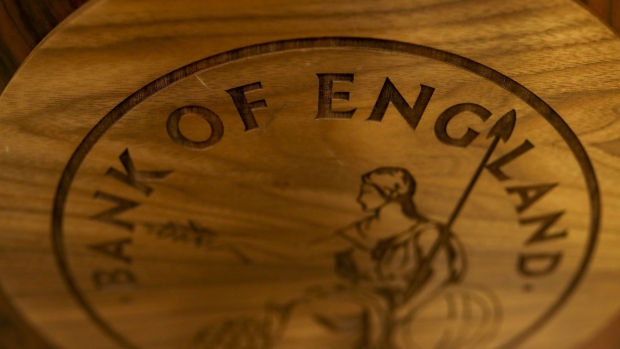Dec 15, 2022
Pound Extends Drop, Gilts Advance After BOE Rate Hike
, Bloomberg News

(Bloomberg) -- The pound posted its worst day versus the dollar in six weeks, while UK government bonds rallied after the Bank of England slowed the pace of monetary tightening, which investors took as a sign that interest rates may peak at a lower level than expected.
Cable fell as much as 1.8% to $1.2430 after the BOE raised interest rates by 50 basis points, while the five-year gilt yield slipped as much as 11 basis points to 3.19%. Analysts noted however, that two members of the Monetary Policy Committee had voted against the hike, preferring to keep rates unchanged following an unprecedented 75-basis point hike in November.
As a result, the nine-member committee was split three ways on the decision, as officials tried to balance the risk of inflation getting entrenched against squeezing too hard on growth, with the UK economy entering a recession.
“The voting split suggests that this is a dovish rate hike,” said Valentin Marinov, FX strategist at Credit Agricole. “The GBP could extend its recent correction lower as investors adjust their BOE rate expectations for 2023.”
The BOE’s dovish stance contrasted with the European Central Bank, which also raised rates by 50 basis points on Thursday but signalled further increases ahead to combat rising prices, pushing the euro 1.5% higher versus the pound to its highest in nearly a month.
Money-market traders pared BOE rate-hike wagers and now price interest rates rising to 4.59% by August, compared to 4.61% before Thursday’s decision.
The BOE’s move comes a day after the Federal Reserve raised rates by a half point and signaled borrowing costs will probably head higher than investors expect next year.
Economists expect the UK to be stuck in a recession for most of 2023, which may help cool inflation pressures. This in turn could mean that BOE tightening reaches a lower level of terminal rates than the market has priced in, said Jeremy Stretch, head of G10 FX strategy at CIBC.
“It’s still the case that the macro backdrop in the UK looks weaker than elsewhere,” said Stretch, who expects rates to peak “just shy” of 4% next year.
“If the BOE are not going to be quite as aggressive in terms of terminal rates compared to where the market is assuming, then that leaves sterling looking potentially vulnerable, if not against the dollar, then certainly against the high-beta currencies,” he said, adding he saw room for the pound to fall further towards $1.2250 in the near term.
The two-year gilt yield slipped as much as 10 basis points to 3.35%, its lowest in nearly a week.
The BOE may find it hard to sustain restrictive policy for a prolonged period, said Pooja Kumra, senior European rates strategist at Toronto-Dominion Bank, who favours shorter-dated gilts over euro-zone government bonds and US Treasuries.
“The BOE, as well as most global firms like the IMF and the OECD, are very negative UK growth,” Kumra said. “Thus, we feel that it is hard for the BOE to continue with a restrictive stance for long.”
Not yet peak rate
The BOE has been raising rates since December 2021 to tame soaring inflation, which hit a 41-year high above 11% in October. But consumer-price growth cooled more than expected in November, raising the possibility that the worst of the cost-of-living squeeze is over.
Some in the market were unconvinced that inflationary pressures were on the wane, given a tight labour market, which may keep upward pressure on wages.
“The recent fall in inflation no doubt played a role in the Bank of England feeling ready to reduce the pace of tightening to a 50 basis-point hike at its meeting today,” said Karen Ward, chief market strategist for EMEA at J.P. Morgan Asset Management.
“However we are not convinced that the UK’s inflation troubles are clearly behind us, and therefore suspect the BOE is still some way away from ‘peak rates’,” she added.
--With assistance from Greg Ritchie, Libby Cherry and Aline Oyamada.
(Updates prices, chart.)
©2022 Bloomberg L.P.






